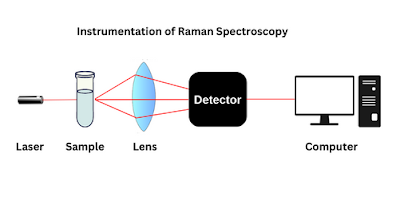Raman Spectroscopy: Principle, Instrumentation and Applications
What is Raman Spectroscopy?
Raman spectroscopy was given by an Indian Physicist Sir C.V Raman, which is based on inelastic scattering of monochromatic light with the sample. The resulting light will have a different frequency than incident light due to this inelastic scattering.
This technique is widely used to analyze vibrational, rotational, and other low-frequency interactions in the molecule. This significantly helps in the elucidation of molecular structure, identifying functional groups, etc.
Principle of Raman Spectroscopy
Raman spectroscopy is based on the inelastic scattering of electromagnetic radiation with the molecule. We have two types of scattering that are elastic and inelastic scattering.
Elastic scattering obeys the Rayleigh law that states that there will be no loss of energy and momentum of the incidence radiation and scattered radiation. That's why this scattering is also known as Rayleigh scattering.
Whereas, there will be some conditions (1 in million) when the energy of the scattered radiation is different from the energy of incidence radiation. This will be called inelastic scattering. These only two possibilities arise.
1. Energy of scattered radiation is less than the incidence radiation: In this type of inelastic scattering. The incidence radiation gives some of its energy to the molecule thus the scattered radiation will have less energy. This is also called Stokes Raman scattering.
2. Energy of scattered radiation is more than the incidence of radiation: In this type of inelastic scattering. The incidence radiation takes some of the vibrational/rotational energy from the molecule itself and thus the scattered radiation will have more energy. This is also called Anti-stokes Raman scattering.
Instrumentation of Raman Spectroscopy
1. Excitation source (laser)
Raman spectroscopy uses a laser as a light source. The radiation of the spectrum depends upon the bandwidth of the laser source used. Generally, a shorter wavelength gives stronger Raman scattering.
2. Sample
A sample is placed in the sample chamber that accepts the laser and it undergoes scattering, both elastic and inelastic which further passes through the filter.
3. Filter
A filter is used in Raman spectroscopy to separate the Raman scattered light from the rayleigh scattered light. This is done to get high-quality Raman spectra. Some filters are notch, long pass, and volume halogen filters.
4. Detector
Detector helps to detect the scattered light signal. Generally, LCD array detectors are used in modern Raman spectrometers. They are optimized to detect signals of different wavelengths and even detect very weak signals.
5. Computer
A computer having suitable compatible software helps to draw a final Raman spectroscopy graph/ spectrum.
Application of Raman Spectroscopy
- It is used to study the structure of CO₂, N₂O, mercurous salts, chloro complexes of mercury, and the nature of bonding.
- It help to study physical chemistry concerning electrolytic dissociation, hydrolysis, and transition from crystalline to amorphous state.
- It is also used to obtain information regarding the presence or absence of specific linkages in a molecule, the structure of simple compounds, and the study of isomers.
- It is used for the characterization of polymer compounds by revealing the physical properties like polymer crystallinity, tacticity, amorphous character, etc.
- It can be easily used for rapid, easy, and accurate analysis of mixtures that are difficult with any other method.




